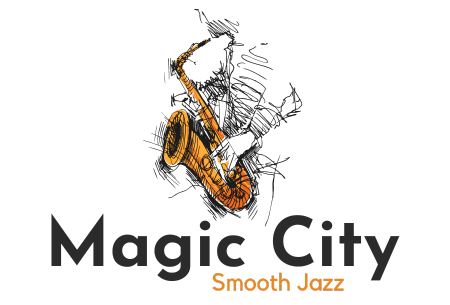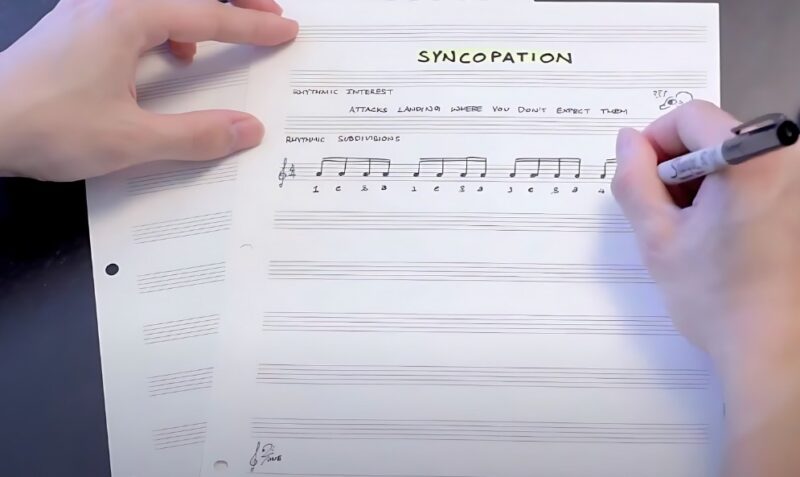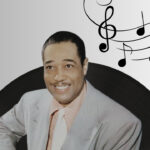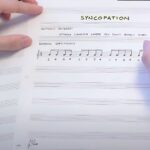Within the complex structure of music, various techniques contribute to its overall impact and appeal. Among these techniques, syncopation stands out as a key element that brings vibrancy and complexity to musical compositions. It’s a tool that disrupts the regular flow of rhythm, introducing an unexpected twist that can transform a simple beat into something captivating.
An Overview
Syncopation is a fundamental musical concept where the rhythm is shifted to emphasize the normally weaker beats in the measure. Instead of following the regular, predictable pulse of the music, it disrupts this flow by accentuating unexpected beats.
This technique involves either stressing the offbeats or inserting pauses where a listener typically anticipates a beat, thereby creating a varied and dynamic rhythmic pattern. Common in a wide array of music genres, it adds an element of surprise, complexity, and energy to music.
4 Types of Syncopated Rhythms

There are four types of this rhythmic technique, each adding a unique flavor to musical compositions.
1. Suspension
Suspension is a fascinating technique where weaker beats are held longer than expected, creating a sense of tension and anticipation in the music. This approach effectively ‘suspends’ the rhythm, delaying the resolution or payoff that listeners typically anticipate.
It’s common in genres that thrive on emotional build-ups and releases, like blues and certain forms of jazz. By extending these weaker beats, suspension syncopation adds depth and emotional complexity to the music, making it more expressive and engaging.
2. Missed Beat
The Missed Beat type is unique in its use of silence as a rhythmic tool. It involves intentionally omitting a beat where a listener would normally expect to hear one, typically a strong beat, and replacing it with a rest.
This creates an unexpected gap in the rhythm, emphasizing the weaker beats around it. The effect is a rhythmic pattern that feels both interrupted and compelling, pushing the boundaries of traditional rhythmic structures.
3. Even-Note
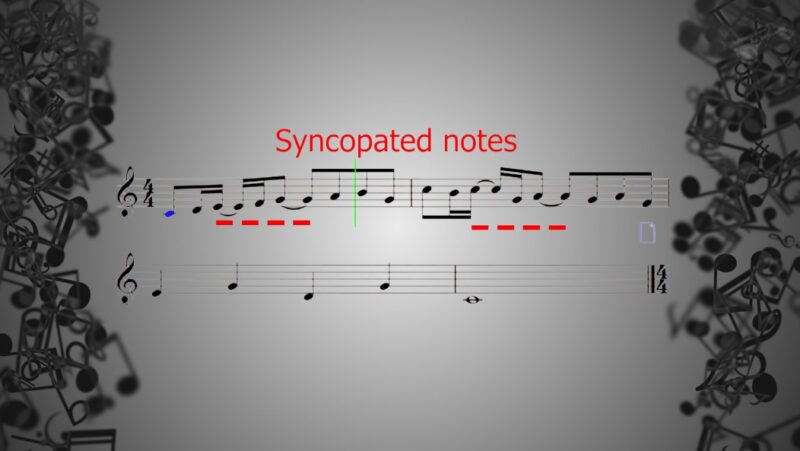
Even-Note is often found in music with even-numbered time signatures, such as 4/4 or 2/4. It emphasizes the second and fourth beats, which are typically weaker in these time signatures.
By accentuating these unexpected beats, Even-Note creates a steady, driving rhythm that is both predictable and off-kilter. It adds an element of steadiness to the rhythm, making the music more approachable and groove-oriented, while still maintaining a level of rhythmic interest and complexity.
4. Offbeat
Offbeat is perhaps the most complex and intriguing of the four types. It shifts notes off the regular pulse of the music, creating intricate and often challenging rhythms. It’s a technique that demands a high level of skill from the musician, requiring precise timing and a deep understanding of rhythmic structure.
How to Implement This Technique?
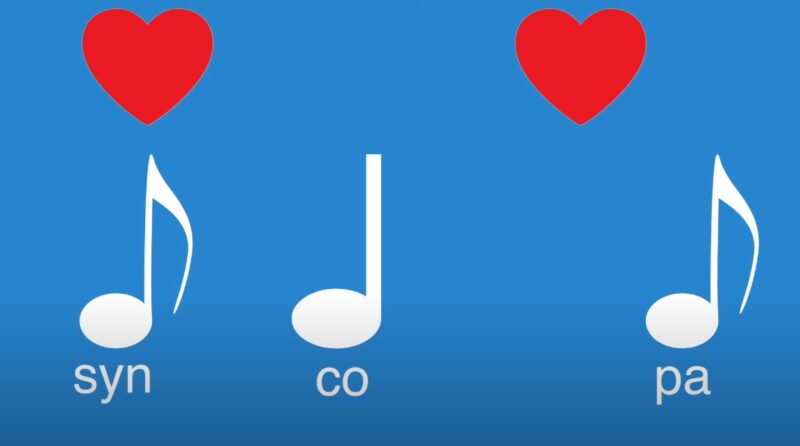
Listening to music rich in syncopated rhythms, such as jazz or funk, can attune the ear to its nuances. Practicing counting out these rhythms, especially with the aid of a metronome, develops a sense of timing. Experimenting with beat placement in compositions can also cultivate an understanding and skill in using this technique.
Attuning the Ear
The first step in mastering this technique is to develop an ear for it. Musicians and enthusiasts are encouraged to immerse themselves in music genres that heavily use it, such as jazz, funk, and certain forms of electronic music.
Actively listening to these styles can help one understand how it affects the overall feel of a piece. Paying attention to how rhythms are constructed and how they interact with other musical elements can provide valuable insights.
Timing with Metronome

A metronome is an essential tool for any musician, especially when working with syncopated rhythms. Practicing with a metronome helps develop a strong sense of timing and rhythm, essential for executing patterns accurately. Start by playing along with the metronome on the regular beats, then gradually introduce syncopated rhythms.
Beat Placement
Experimentation is key in incorporating syncopation into the music. Musicians should try altering the placement of beats in their compositions, focusing on shifting emphasis to off-beats or weaker beats.
Recording and Analyzing
Listening back to recordings allows musicians to critically assess their use of syncopation. This process can be taken a step further by converting these recordings to MIDI, which offers a visual representation of the rhythms. Analyzing these MIDI patterns can reveal insights into the structure and impact of rhythms.
By Using Technology
Drum machines, rhythm apps, and music production software often have features that allow for the exploration of complex rhythmic patterns. These tools can simulate different types of syncopation and provide a platform for experimentation.
Collaborate with Other Musicians
Collaborating with other musicians can provide a different perspective on syncopation. Playing with others, especially those who are proficient in syncopated rhythms, can be an invaluable learning experience. It allows for the exchange of ideas and techniques, and the opportunity to experience how it works in a group setting.
Live Performances
Live performances offer the chance to experiment with rhythmic variations and see how they resonate with an audience. This real-time feedback is crucial for understanding the effectiveness of different patterns. It also allows musicians to develop their ability to use it spontaneously.
Syncopation Across Genres
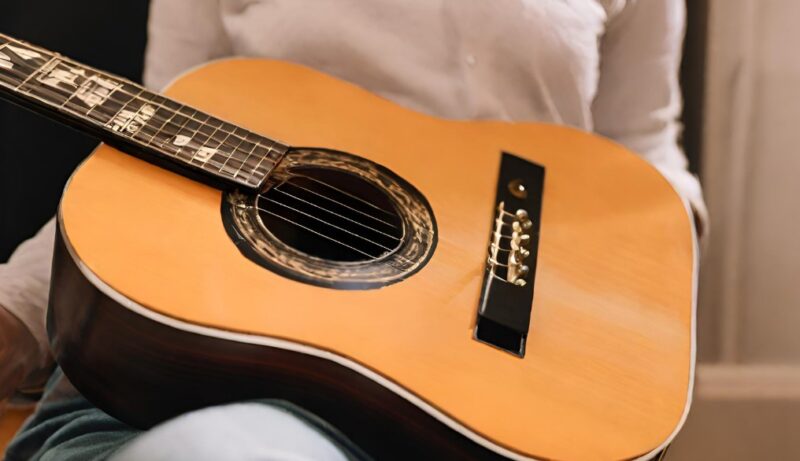
From the improvisational swings of jazz to the pulsating beats of electronic dance music, syncopation is a key element that contributes significantly to the identity and appeal of different music genres.
Jazz
Jazz is often considered the birthplace of modern syncopation. Its intricate rhythms and emphasis on improvisation make extensive use of syncopation, giving jazz its distinctive swing and groove.
The use of this technique in jazz often involves complex interplay between different instruments, creating a rich tapestry of sound that is both challenging and rewarding for musicians and listeners alike.
Listening live performances is also a great way to learn more about how professionals are applying it. Jazz Clubs might be the best option. If you find yourself in Las Vegas, make sure to visit some of the best jazz clubs there.
Funk and Rap
These genres often employ tight, syncopated rhythms that create a strong, driving beat. Funk music, in particular, uses syncopation to create an irresistibly danceable feel, often through the interplay of bass and drums. In rap, syncopated rhythms are used in the flow and delivery of lyrics, adding dynamism and energy to the vocal performance.
Electronic Dance Music
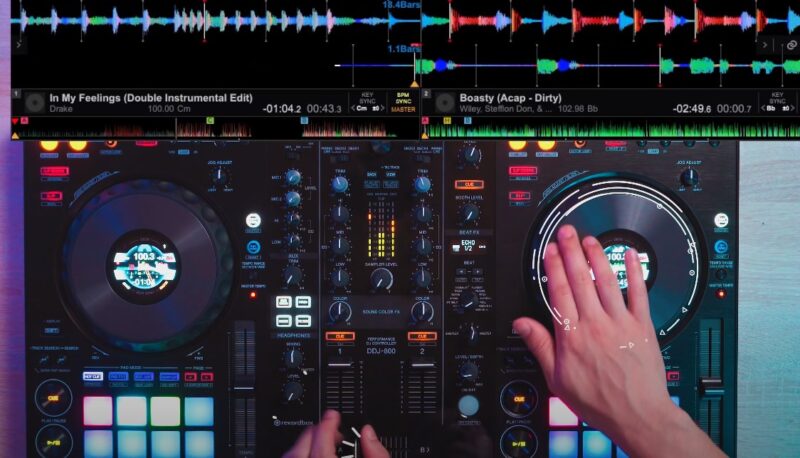
The genre often uses syncopated rhythms to create build-ups and drops, essential elements of the EDM experience. These rhythms add excitement and anticipation to the tracks, keeping listeners engaged and on their feet. The use of technology in EDM allows for a high degree of precision in creating and manipulating syncopated beats, leading to innovative rhythmic patterns that define the genre’s cutting-edge sound.
Reggae
Reggae music is renowned for its distinctive offbeat syncopation. This genre often places rhythmic emphasis on the offbeat, creating a relaxed yet compelling groove. The syncopated offbeat rhythms in reggae contribute to its laid-back feel but are underpinned by a strong sense of timing and rhythm.
Pop Music
Pop songs often use syncopated beats to create a sense of movement and excitement, helping them stand out on the radio and in playlists. Notable examples include Major Lazer’s “Lean On” and The Police’s “Don’t Stand So Close to Me,” where syncopated rhythms play a pivotal role in the songs’ success.
FAQs
Who invented syncopation?
Syncopation is not a single invention, but a musical technique that has evolved over time and across cultures. Some of the earliest examples of syncopation can be traced back to the 14th-century European music and the African-American musical traditions.
What are the rules for syncopation?
There are no fixed rules for syncopation, but some common ways to create syncopation are: shifting the accent to a weak beat or an offbeat, playing a note before or after the expected beat, tying a note across a strong beat, or using rests to create silence on a strong beat.
What famous songs have syncopation in them?
Syncopation is used in many musical styles and genres, especially in dance, jazz, rock, and pop music. Some famous songs that have syncopation in them are: “Billie Jean” by Michael Jackson, “Hey Jude” by The Beatles, “Bohemian Rhapsody” by Queen, “So What” by Miles Davis, and “No Woman, No Cry” by Bob Marley.
Is syncopation melody or rhythm?
Syncopation is a rhythmic technique that affects the melody and harmony of a piece of music. Syncopation creates a sense of surprise, tension, or groove by altering the expected pattern of strong and weak beats. Syncopation can be applied to any musical element, such as notes, chords, drums, or vocals.
Summary
While syncopation is a key element in creating engaging and dynamic music, it’s just one part of the broader concept of rhythm. Rhythm in music is the framework that organizes the timing of notes and beats.
Regular repeating patterns of accented (strong) and unaccented (weak) beats form the backbone of most musical pieces. The downbeat, or the first beat of a measure, is typically the most accented and sets the pace for the following beats. In contrast, syncopation plays with this established order, often placing rhythmic stresses on beats that are traditionally unaccented.
To truly appreciate and identify syncopation, you should explore a range of songs known for their use of this technique. “Orinoco Flow” by Enya and “Stay (Wasting Time)” by Dave Matthew’s Band are prime examples. Even in odd time signatures like 7/8, where off-beats naturally play a significant role, the use of syncopated rhythms is evident.
